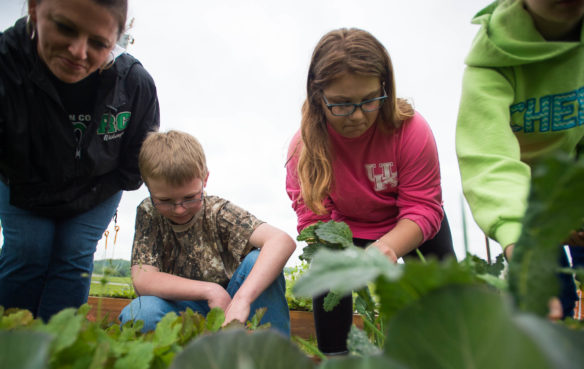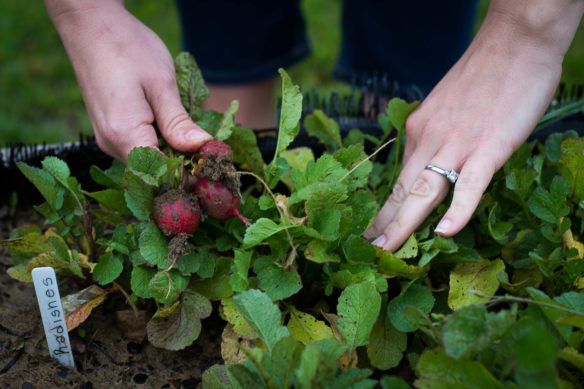
Sixth-graders Gabe Kidd, left, and Jenna Hunt help teacher Jennifer Pecco pick kale out of one of the raised garden beds at Rowan County Middle School. The beds are part of the school’s project-based learning initiative to combat hunger in the community.
Photo by Bobby Ellis, May 18, 2016
By Brenna R. Kelly
Brenna.kelly@education.ky.gov
As they walked into the gym for a beginning of the year assembly, some Rowan County Middle School students randomly received a red strip of paper and no explanation.
Then a teacher asked all of the students holding a red paper to stand. The standing students, she told the assembly, represented the 36.5 percent of school-age children in Rowan County living in poverty.
“It was eye opening for some of our kids to realize just how many kids that they see every day are living on the fringe,” said Paula Stafford, the school’s assistant principal.
The exercise kicked off a new way of teaching and learning at the nearly 700 student school – a schoolwide project-based learning initiative designed to improve student learning and make a difference in the community.
“Our teachers came up with a driving question for the year,” Stafford said. “What can you bring to the table to combat hunger in our community?”
Teachers in all content areas revamped their lessons to incorporate the question and developed projects to help the students answer it using the content they learned in class, Stafford said.
Projects included growing vegetables in raised garden beds, volunteering at a soup kitchen, selling plants, working with the U.S. Forest Service to study pollinators, creating art for the school’s lobby, writing poetry and more.
“It’s made the learning much more engaging for the students,” Stafford said. “They see a real purpose for what they are doing and that there’s a real outcome beyond them in what they are doing.”

Jennifer Pecco, 6th-grade science teacher, picks radishes from one of the raised garden beds at Rowan County Middle School.
Photo by Bobby Ellis, May 18, 2016
School administrators decided to embrace project-based learning as a part the National Forum to Accelerate Middle Grades Reform’s Schools to Watch program, designed to improve and recognize middle-grade schools. The program focuses on four areas: academic excellence, developmental responsiveness, social equity, and organizational structures and processes.
About the same time the school joined the program, it received a grant from the 21st Century Education Enterprise at Morehead State University, which allowed 17 teachers – more than half of the school’s staff – to attend a weeklong training on project-based learning.
“It was a big puzzle that all came together for us,” Stafford said. “We had several pieces that all came to us at a time that we needed them.”
Choosing to focus on community hunger was a natural fit for the school, she said. More than 60 percent of the school’s students qualify for free or reduced-priced lunch and many student’s families rely on the Community Soup Kitchen, which is across the street from the school, Stafford said.
“When the economy downturned, it really did downturn for everybody and a lot of our agriculture jobs have disappeared,” she said. “So we have more people living at that borderline than we ever have had before. It’s a need that’s right here and we wanted to see what we could do.”
Teachers worked together to plan projects across disciplines. For example, students learning about pollinators in science were then able to write persuasive pieces in their language arts class, Stafford said.
“The teachers are talking to each other and they are more familiar with each other’s content and how to make those integrated connections for kids,” she said. “It’s kind of like the old one-room school where everybody knows what everyone else is doing.”
For her 6th-grade science classes, teacher Jennifer Pecco decided to have students grow vegetables and herbs in raised beds.
“A lot of our kids don’t understand how our food gets to where it is,” Pecco said. “So as I looked at my units, I looked for ways I could gradually incorporate the gardens. Then as we got started, it just kind of all seemed to really fit – more than I ever thought it would.”
When Pecco taught the students about matter, she explained about essential elements in plants. When students watered the gardens, she taught them about the chemical structure of water and the water cycle. For earth science, Pecco taught the students about the elements in the soil and where they came from.
Students worked with worms to learn how they turn rotten vegetables into composting for the garden, she said.
“It’s been a lot of light bulb moments for them where they see why I’m making them learn chemistry,” she said. “They see, ‘Oh, all that stuff she’s talking about, it really does impact me and the food that I eat.’”
After the fall harvest, students raised more than $350 dollars by selling the vegetables at parent/teacher conferences and around the school. They decided to use the money to buy 24 turkeys for Thanksgiving baskets given to students’ families by the school’s Youth Services Center.
“We’re trying to make a connection with how we can raise our food, but also earn money and use it to contribute to the cause,” she said. “They are learning to be stewards, to do good for their community.”
One the students’ favorite projects was volunteering at the soup kitchen, Stafford said. Teachers volunteered to give up a planning period about once every three to four weeks to take three to five students to the soup kitchen, she said.
The students serve meals, clean up and do whatever the staff needs done, she said.
“We’ve had several parents who have emailed or called us about the powerful, positive influence this has had on their children in making their children more cognizant of what’s going on and teaching them empathy and sensitivity,” Stafford said.
Stafford also has seen the impact volunteering at the soup kitchen has had on the students. During dismissal, Stafford often asks students what was the best part of their school day.
“Every kid that has gone to the soup kitchen that day, says that going to the soup kitchen was the best part of their day,” she said.
MORE INFO …
Paula Stafford Paula.Stafford@rowan.kyschools.us
Jennifer Pecco Jennifer.Pecco@rowan.kyschools.us









Leave A Comment